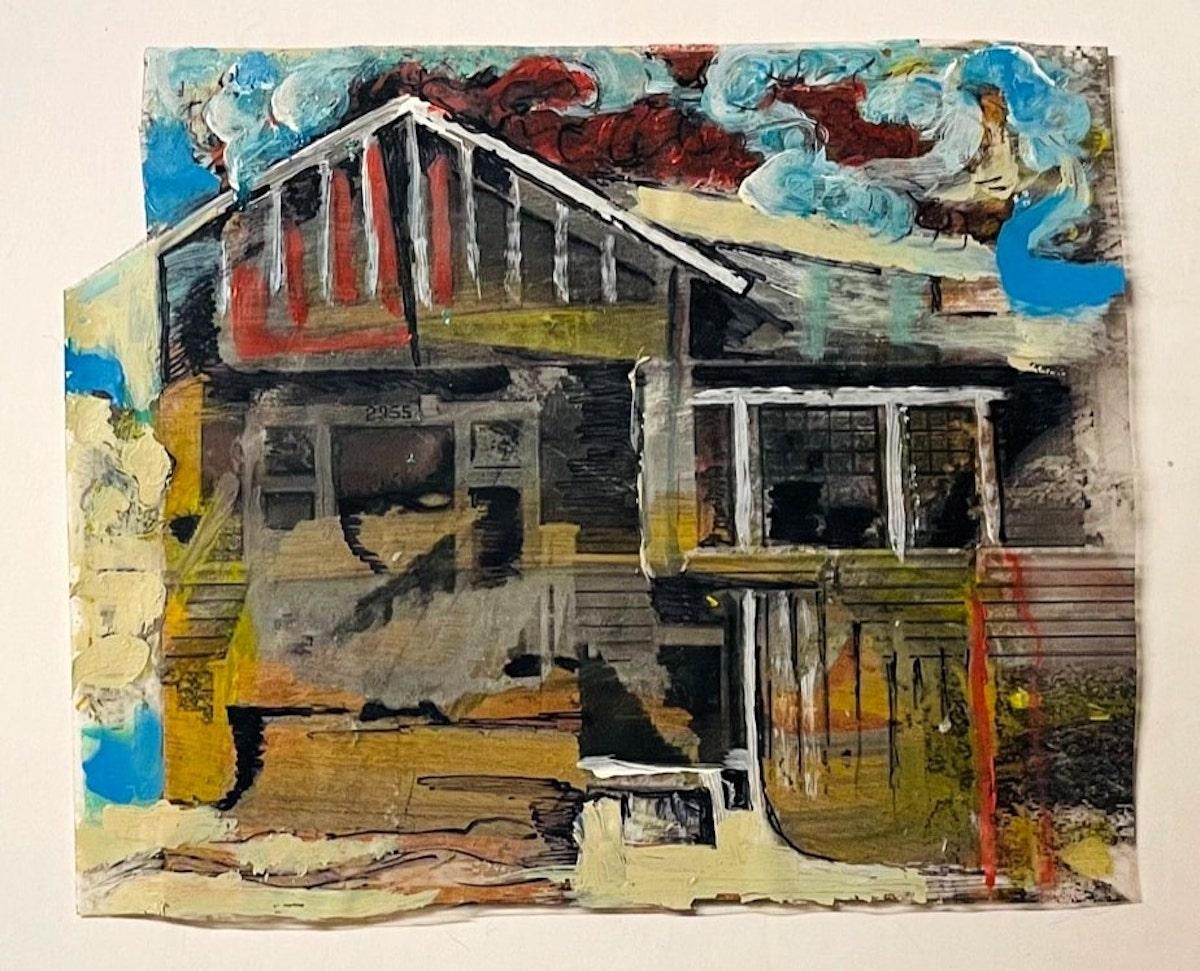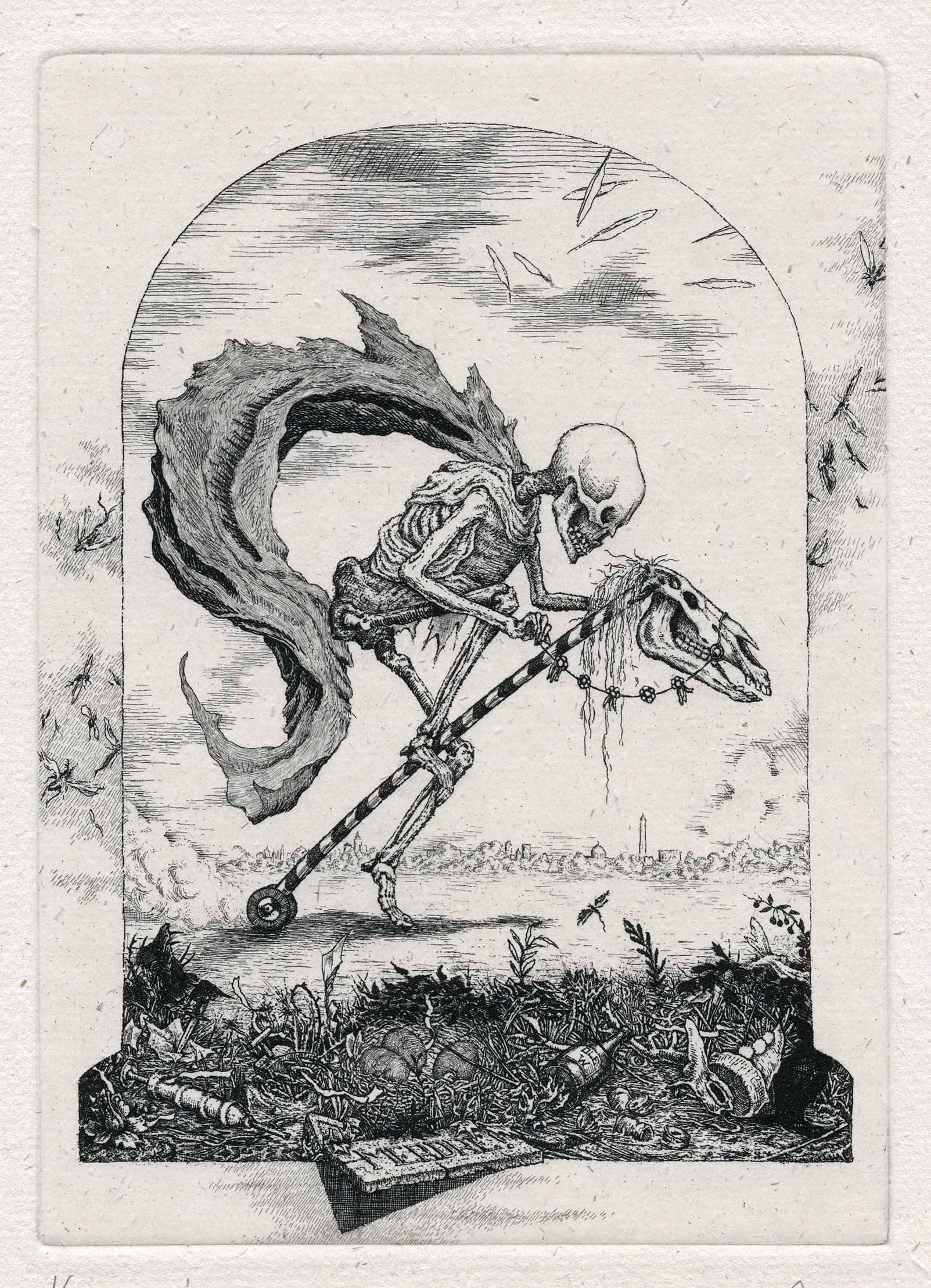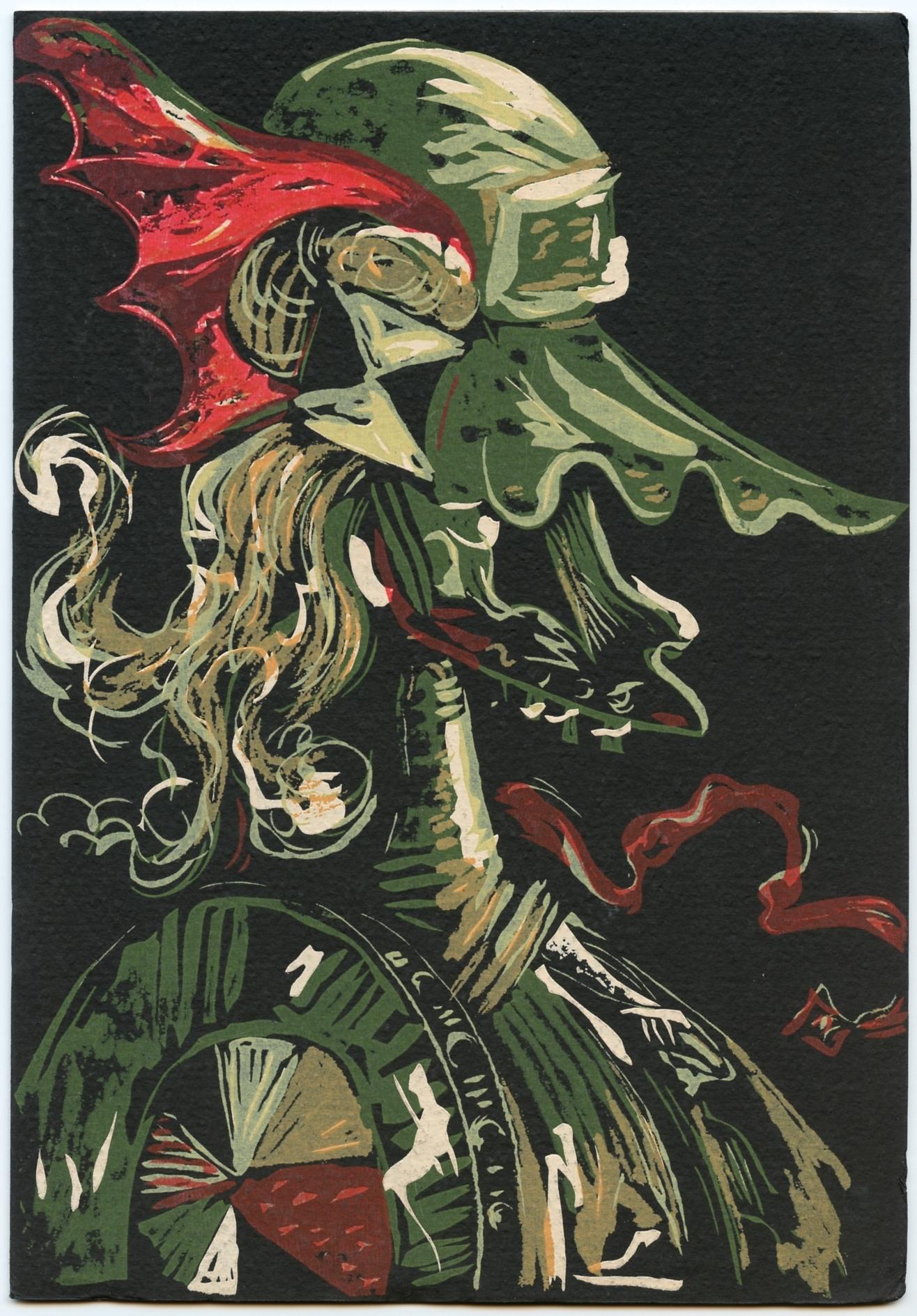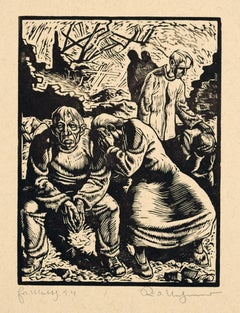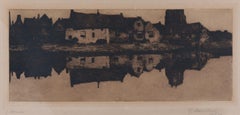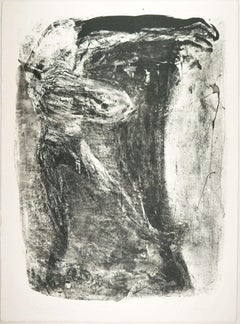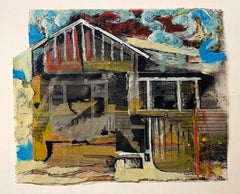Want more images or videos?
Request additional images or videos from the seller
1 of 8
Jörg OlbergAgony - The architecture of decay -1987
1987
$265.01
$331.2720% Off
£201.46
£251.8220% Off
€224
€28020% Off
CA$372.44
CA$465.5520% Off
A$405.04
A$506.2920% Off
CHF 213.38
CHF 266.7320% Off
MX$4,919.23
MX$6,149.0420% Off
NOK 2,682.64
NOK 3,353.3020% Off
SEK 2,514.76
SEK 3,143.4520% Off
DKK 1,715.36
DKK 2,144.2020% Off
About the Item
Jörg Olberg (*1956 Dresden), Agony, 1987. etching, E.A. (edition of 30), 24 x 17 cm (image), 46 x 37 cm (sheet), each signed in pencil lower right "Olberg" and dated "IX [19]87", inscribed lower left "E.A. [Epreuve d'Artiste]".
- minimal crease and dust stains in the broad margin
- The architecture of decay -
About the artwork
Jörg Olberg draws here the sum of his artistic study of the Berlin ruins, which were still present in the cityscape well into the 80s. With his work "Agony" he creates an allegory of decay. Positioned in the landscape of ruins, a ruined house grows before the viewer, rising like the Tower of Babel into the sky, its roof and gable brightly illuminated by the sun. But already the roof shows mostly only the rafters, and as the gaze is drawn further down, the building visibly disintegrates, the beams protruding in all directions looking like splintered bones. Slowly but inexorably - in agony - the house will collapse in on itself and become nothing more than the burial mound of itself. At the same time, the small-scale stone composition and the plaster form a pattern-like ornamentation of decay.
The tension in the picture is fed by the counter-movement of growth and collapse, which is heightened by the dramatic formation of clouds. The swirls of clouds are reminiscent of a world landscape, such as Albrecht Altdorfer's Battle of Alexandria (1529). And the ruin - this is the further allegorical content - stands pars pro toto for the world as such. In this way, Olberg creates a modern memento mori in an architectural language of forms that is a key work of his early oeuvre.
About the artist
Born in Dresden, Germany, Jörg Olberg trained as a goldsmith, studied architecture in Weimar, and graphic design at the Kunsthochschule Berlin-Weißensee. Since graduating in 1986, he has worked as a freelance artist in Berlin. Throughout his career, Olberg has focused on Berlin's urban landscape, and in his early work he was fascinated by the ruinous side of the city that still existed in the 1980s.
GERMAN VERSION
Jörg Olberg (*1956 Dresden), Agonie, 1987. Radierung, E.A. (Auflage 30 Stück), 24 x 17 cm (Darstellung), 46 x 37 cm (Blattgröße), jeweils in Blei unten rechts mit „Olberg“ signiert und mit „IX [19]87“ datiert, unten links als „E.A. [Epreuve d'Artiste]“ bezeichnet.
- minimale Knick- und Staubspuren im breiten Rand
- Die Architektur des Verfalls -
zum Kunstwerk
Jörg Olberg zieht hier gleichsam die Summe seines künstlerischen Studiums der Berliner Ruinen, die noch bis weit in die 80er Jahre hinein im Stadtbild präsent waren. Mit seinem Werk „Agonie“ schafft er eine Allegorie des Verfalls. In der Schuttlandschaft positioniert, wächst vor dem Betrachter ein ruinöses Haus empor und ragt – wie der Turmbau zu Babel – in den Himmel hinein, wo das Dach und der Giebel hell von der Sonne beschienen werden. Aber bereits das Dach zeigt größtenteils nur noch die Sparren und wird der Blick weiter nach unten geführt, löst sich das Gebäude zusehends auf, wobei die in alle Richtungen ragenden Balken wie gesplitterte Knochen wirken. Langsam aber unaufhaltsam – in Agonie – wird das Haus in sich zusammenstürzen und nur noch den Grabhügel seiner selbst ausmachen. Dabei bilden der kleinteilige Steinverbund und der Putz eine musterförmige Ornamentalität des Verfalls.
Aus der Gegenbewegung von Aufwachsen und Einstürzen speist sich die Bildspannung, die von der dramatischen Wolkenbildung noch gesteigert wird. Die Wolkenwirbel gemahnen an eine Weltlandschaft, wie sie mit Albrecht Altdorfers Alexanderschlacht (1529) vor Augen steht. Und die Ruine – dies ist der weitergehende allegorische Gehalt – steht pars pro toto für die Welt als solche ein. Damit schafft Olberg ein modernes memento mori in architektonischer Formensprache, das ein Schlüsselwerk seines frühen Oeuvres darstellt.
zum Künstler
Gebürtig aus Dresden absolvierte Jörg Olberg eine Goldschmiedelehre und ein Architekturstudium in Weimar und studierte anschließend Grafikdesign an der Kunsthochschule Berlin-Weißensee. Seit dem Abschluss 1986 ist er in Berlin freiberuflich als Künstler tätig. Über sein Oeuvre hinweg widmet sich Olberg der Berliner Stadtlandschaft, wobei ihn in seinem Frühwerk die in den 80er Jahre immer noch präsente ruinöse Seite Berlins faszinierte.

About the Seller
5.0
Vetted Professional Seller
Every seller passes strict standards for authenticity and reliability
Established in 2014
1stDibs seller since 2023
22 sales on 1stDibs
- ShippingRetrieving quote...Shipping from: Berlin, Germany
- Return Policy
Authenticity Guarantee
In the unlikely event there’s an issue with an item’s authenticity, contact us within 1 year for a full refund. DetailsMoney-Back Guarantee
If your item is not as described, is damaged in transit, or does not arrive, contact us within 7 days for a full refund. Details24-Hour Cancellation
You have a 24-hour grace period in which to reconsider your purchase, with no questions asked.Vetted Professional Sellers
Our world-class sellers must adhere to strict standards for service and quality, maintaining the integrity of our listings.Price-Match Guarantee
If you find that a seller listed the same item for a lower price elsewhere, we’ll match it.Trusted Global Delivery
Our best-in-class carrier network provides specialized shipping options worldwide, including custom delivery.More From This Seller
View AllThe Zero Hour / - After the End of the World -
Located in Berlin, DE
Rudolf Nehmer (1912 Bobersberg - 1983 Dresden), The Zero Hour, 1948. Woodcut on yellowish wove paper, 20 cm x 14.8 cm (image), 43 cm x 30 cm (sheet size), signed “Rud.[olf] Nehmer” i...
Category
1940s Realist Figurative Prints
Materials
Woodcut
Evening - The depth of the visible -
Located in Berlin, DE
Max Clarenbach (1880 Neuss - Cologne 1952), Evening. Etching, 18 x 41 cm (platemark), 33.5 x 57 cm (frame), inscribed "Abend" in pencil at lower left, signed and dated "M. Clarenbach. 28.III.[19]09". Framed and mounted under glass.
- Somewhat browned and slightly foxed.
About the artwork
The horizontally elongated etching depicts the panoramic view of a small town as seen from the other side of the river. There are gabled houses on the left and a mighty church spire on the right. The bourgeois houses and the large religious building indicate the urban character. These buildings are rendered in dark tones to emphasise the lighter row of houses in the centre of the picture, closer to the water. The chiaroscuro contrast creates two parallel planes that open up a space for the imagination of what the city could be. The imagination is stimulated by the almost entirely dark, barely recognisable buildings, while the arm of the river leading into the city further stimulates the imagination.
However, as the silhouette of the city as a whole is reflected in the water, the parallel planes are perceived as a band of houses that stretches across the entire horizontality of the etching and seems to continue beyond the borders of the picture. The reflection has almost the same intensity as the houses themselves, so that the band of buildings merges with their reflection to form the dominant formal unit of the picture. Only the parallel horizontal hatching creates the convincing impression of seeing water, demonstrating Max Clarenbach's mastery of the etching needle.
The water is completely motionless, the reflection unclouded by the slightest movement of the waves, creating a symmetry within the formal unity of the cityscape and its reflection that goes beyond the motif of a mere cityscape. A pictorial order is established that integrates everything in the picture and has a metaphysical character as a structure of order that transcends the individual things. This pictorial order is not only relevant in the pictorial world, but the picture itself reveals the order of the reality it depicts. Revealing the metaphysical order of reality in the structures of its visibility is what drives Clarenbach as an artist and motivates him to return to the same circle of motifs.
The symmetry described is at the same time inherent an asymmetry that is a reflection on art: While the real cityscape is cut off at the top of the picture, two chimneys and above all the church tower are not visible, the reflection illustrates reality in its entirety. The reflection occupies a much larger space in the picture than reality itself. Since antiquity, art has been understood primarily as a reflection of reality, but here Clarenbach makes it clear that art is not a mere appearance, which can at best be a reflection of reality, but that art has the potential to reveal reality itself.
The revealed structure of order is by no means purely formalistic; it appears at the same time as the mood of the landscape. The picture is filled with an almost sacred silence. Nothing in the picture evokes a sound, and there is complete stillness. There are no people in Clarenbach's landscape paintings to bring action into the picture. Not even we ourselves are assigned a viewing position in the picture, so that we do not become thematic subjects of action. Clarenbach also refrains from depicting technical achievements. The absence of man and technology creates an atmosphere of timelessness. Even if the specific date proves that Clarenbach is depicting something that happened before his eyes, without the date we would not be able to say which decade, or even which century, we are in. The motionless stillness, then, does not result in time being frozen in the picture, but rather in a timeless eternity that is nevertheless, as the title "Abend" (evening), added by Clarenbach himself, makes clear, a phenomenon of transition. The landscape of the stalls is about to be completely plunged into darkness, the buildings behind it only faintly discernible. The slightly darkened state of the sheet is in keeping with this transitional quality, which also lends the scene a sepia quality that underlines its timelessness. And yet the depiction is tied to a very specific time. Clarenbach dates the picture to the evening of 28 March 1909, which does not refer to the making of the etching, but to the capture of the landscape's essence in the landscape itself.
If the real landscape is thus in a state of transition, and therefore something ephemeral, art reveals its true nature in that reality, subject to the flow of phenomena, is transferred to an eternal moment, subject to a supra-temporal structure of order - revealed by art. Despite this supratemporality, the picture also shows the harbingers of night as the coming darkening of the world, which gives the picture a deeply melancholy quality, enhanced by the browning of the leaf.
It is the philosophical content and the lyrical-melancholic effect of the graphic that give it its enchanting power. Once we are immersed in the image, it literally takes a jerk to disengage from it.
This etching, so characteristic of Max Clarenbach's art, is - not least because of its dimensions - a major work in his graphic oeuvre.
About the artist
Born into poverty and orphaned at an early age, the artistically gifted young Max Clarenbach was discovered by Andreas Achenbach and admitted to the Düsseldorf Art Academy at the age of 13.
"Completely penniless, I worked for an uncle in a cardboard factory in the evenings to pay for my studies.”
- Max Clarenbach
At the academy he studied under Arthur Kampf, among others, and in 1897 was accepted into Eugen Dücker...
Category
Early 1900s Realist Landscape Prints
Materials
Etching
$548 Sale Price
20% Off
My treasure, my sanctuary / - A Tortured Treasure -
Located in Berlin, DE
Johannes Heisig (*1953 Leipzig), "My treasure, my sanctuary" - To the Christmas Oratorio by Johann Sebastian Bach. Lithograph on strong yellowish laid paper with watermark, 53 x 39.5...
Category
1980s Abstract Expressionist Figurative Prints
Materials
Lithograph
$359 Sale Price
20% Off
Untitled / - The archaism of nature -
Located in Berlin, DE
Jorge Machold (1940 Chemnitz - 2015 Berlin), Untitled, 1973. Color etching, 41.5 x 29.2 cm (plate size), 49.5 cm x 39.5 cm (sheet size), signed lower right in lead “J.[orge] Machold”...
Category
1970s Abstract Abstract Prints
Materials
Paper
Threatening to defeat me once and for all / - A Christmas Pietà -
Located in Berlin, DE
Johannes Heisig (*1953 Leipzig), "Threatening to defeat me once and for all" - To the Christmas Oratorio by Johann Sebastian Bach. Lithograph on strong yellowish laid paper with wate...
Category
1980s Abstract Expressionist Figurative Prints
Materials
Lithograph
$359 Sale Price
20% Off
Self / - Inversion -
Located in Berlin, DE
Kurt Mühlenhaupt (1921 Klein Ziescht - 2006 Berlin), Myself, c. 1975. Woodcut, 32 cm x 29 cm (image), 36.5 cm x 32.5 cm (sheet size), signed in pencil lower right and titled “Selbst....
Category
1970s Realist Figurative Prints
Materials
Paper
You May Also Like
Demeure Archéologiques
By Anne-Marie DEBELFORT
Located in Atlanta, GA
Anne-Marie Debelfort is a French painter born in 1947. She studied at the National School of Fine Arts from 1967 to 1972 and obtained a diploma of fine arts with honors. In 1973 she ...
Category
21st Century and Contemporary Modern Landscape Paintings
Materials
Oil
Manor Arena
Located in San Francisco, CA
This artwork "Manor Arena c.1980 is an original etching on Japan paper by noted French abstract expressionist artist Francois Rouan, b.1943. It is hand ...
Category
Late 20th Century Abstract Expressionist Abstract Prints
Materials
Etching
Dwellings 5
By Iliyan Ivanov
Located in New York, NY
This series “Dwellings” is comprised of pieces of mixed media on wood panels. The artist uses wood panels 5 x 5 inches each as base that is painted ei...
Category
2010s Conceptual Mixed Media
Materials
Wood, Paper, Acrylic, Permanent Marker, Monoprint
Turmgasschen
By Luigi Kasimir
Located in San Francisco, CA
This artwork titled "Turmgasschen" 1935 is an original color etching by Austrian artist Luigi Kasimir 1881-1962. It is hand signed in pencil at the lower center by the artist and titled in the plate. The plate mark (image) size is 15.5 x 10 inches, framed is 24.35 x 17.5 inches. It is custom framed in a dark wood frame, with light creme color matting and light brown filet. It is in very good condition, the frame have some scratches.
Luigi Kasimir was born in 1881 at Pettau, today Ptuj, Slovenia, then a part of the Austro-Hungarian monarchy. He inherited his talent from his ancestors; his grandfather was a painter and a poet, and his father an officer in the Habsburg army, who later became a professional painter. Kasimir attended the Vienna Academy of Art where he studied under Wilhelm Unger, who introduced him to the technique of the coloured etching, and also to his future wife, the artist Tanna Hoernes.[1] He died in 1962 in Grinzing, a suburb of Vienna.Kasimir was among the first to develop the technique of the coloured etching. Before this, prints were usually hand-coloured with the colour being applied in a casual, haphazard manner. Kasimir would first create a sketch usually in pastel, he then transferred the design on as many as four to six plates, printing one after the other and applying the colour on the plate, all done by hand.
Kasimir is mainly famous for his etchings, but he also produced some oil painting, as well as some pastels. One of his favourite genres was the landscape, or veduta. He demonstrated a predisposition street scenes, and tourist landmarks. He depicted places from all over Europe, mainly Italy, Austria, and Germany. He also travelled to the United States to do a series of etchings of famous sights ranging from urban landmarks such as New York City skyscrapers, to natural wonders like Yosemite Valley. Luigi Kasimir’s etchings...
Category
Early 20th Century Realist Figurative Prints
Materials
Etching
A Post-Traumatic History Lesson
By David Avery
Located in Palm Springs, CA
Signed and numbered from the edition of 30. Avery's prints often mix elements of satire, myth and legend with his own light touch of surrealism.
David Avery continues to explore the expressive and technical possibilities inherent in black and white line etching...
Category
Early 2000s Figurative Prints
Materials
Etching
(after) Kurt Seligmann - pochoir
By Kurt Seligmann
Located in Henderson, NV
Medium: pochoir (after the painting). This exquisitely rich impression on black wove paper was published in 1941 by the Nierendorf Gallery, of New York, for the cover of a now quite ...
Category
1940s Surrealist Figurative Prints
Materials
Lithograph
More Ways To Browse
German Train
Kaws Poster
Library Posters
Lucian Freud Etching
Maryan Pinchas
Montreux Jazz Festival
Nike Sneakers
Picasso Hibou
Plato Dialogues
Richard Gilbert
Richard Strauss
Roman Polanski
Salvador Dali Horse
Saul Steinberg On Sale
Shinsui Ito
Signed Print Leroy Neiman
Toulouse Lautrec Original Print
Vintage 70S T Shirts

